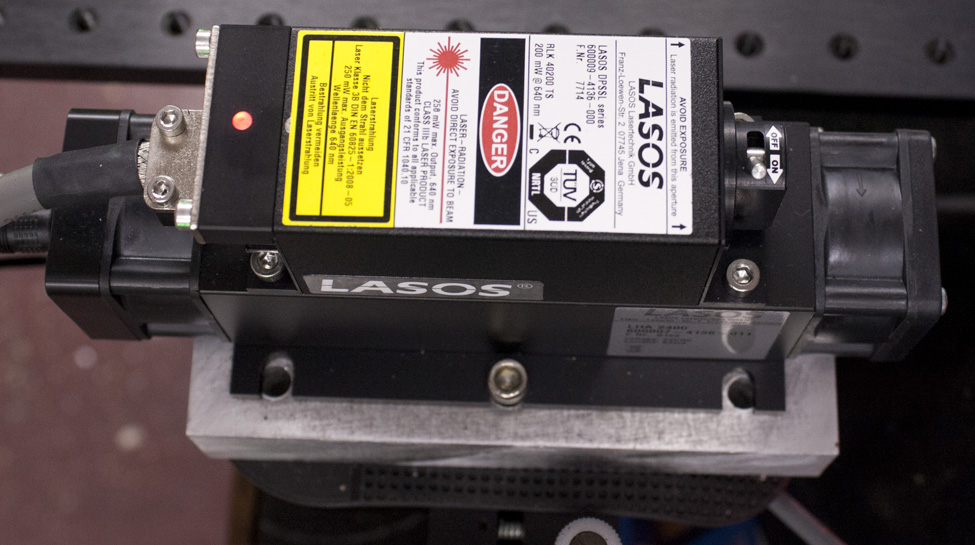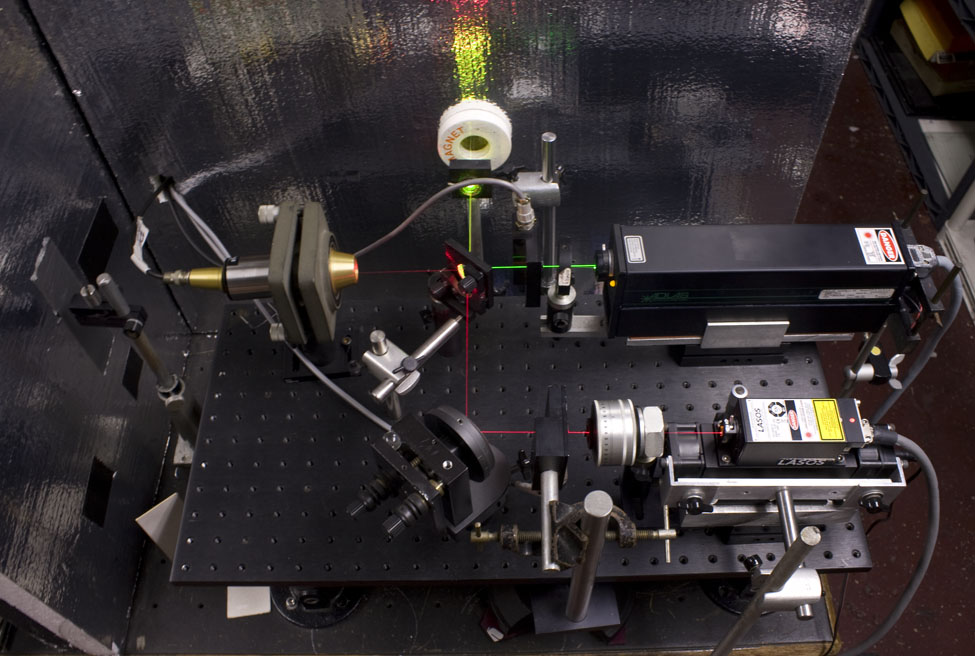
.
Acquisition Date: April 2015
Date of Manufacture:2004
Country of Origin: California, USA
List Price (when new): $10k (?)
Purchased New
Provenance: I bought it brand new from the factory via Lynn Srickland, Lasos's US Distributor in the Fall of 2015. I had made a lot of money from holographic consulting that year, and had to make a major purchase to write off so as to not jeopardize my Social Security income. (One cannot make more than a certain amount per year when on that social safety net!)
I wired the money to Germany, and they shipped it DHL, but the State of Illinois somehow got wind of the purchase, and they billed me for sales tax on the item! Be aware of this if you purchase something from Lasos, or any other country.
Pedigree:
RLK stands for Red Laser, K for single frequency, the first 2 digits of the product number are the last 2 digits of the wavelength (Lasos assume it's understood that the first digit is 6, as the laser is red), and the last 3 digits are the power in milliWatts. Although mine is a nominal 200 mW job, its software says the laser is only putting out 198 mW.
Personal Experiences:
I would recommend this laser to anyone needing a strong red, but not 100%. This laser is the BMW of my collection; made in Germany, beautiful looking, high performance, but not without serious faults. (Just like the BMW car and motorcycle I own.) I am on my 2nd one, thank God under warranty, because the first blew its little brains out. And I have to preface this missive just like we used to do during classroom critique that it is about the work, not the people, as I have found that our US sales rep, Lynn Strickland, and the others I have dealt with at the factory are very nice folks, but this tough love is aimed at the engineers, who need to hear these scathing comments so that the next generation of their lasers address and fix these rather serious faults.
The first serious offense is the need for a cooling fan. When I ordered the laser, I added the heat sink, (better to be safe than sorry!) although I never got a definitive answer from the factory whether it was necessary or not; how do they not know if their unit needs it? Is it too much to ask to test this in their lab? So Lasos sells a heat sink with fans mounted on either end, one sucking, the other blowing, and since the two motors were not both going at exacty the same speed, there was some sort of vibrational standing wave that shook the table. Not only could you see the fringes dance in an interferometer, you could feel it on the table!
What I first did to solve the vibrations of the cooling system was to put a switch in-line from the power supply to the fan, as the factory has no provisions for shutting it off except for unplugging it. But sometimes I would forget either to turn the fan on off during an exposure, or back on after the exposure. So then I built a box to go in-line that was connected to my trusty Uniblitz T132 Shutter, which shut the fan off during the settle time and exposure.
But then I was shooting photopolymers with this laser, and although it is 200 mW, exposures were in the minutes. Not wanted to have the fans off for that length of time, I removed them from the heat sink and mounted them on their own separate rig, supported off the floor, almost touching the heat sink but not quite, so the air is blown through the sink but without the fans' vibrations getting into the table.

The manual does state that the heat sink needs to dissipate 15 Watts, and it definitely needs to be taken away, as my first one stopped being SLM when it was left on for about 36 hours without the fan being on. I had turned the laser off with the software and the fan with a switch in its circuit when I kicked off for the weekend. There had been a power interruption in the Home + Studio, and when the juice came back on, the laser thought it had a wake up call, and it arose, but the fan didn't get the message. So the laser ran for about 36 hours without the cooling fan, and was painfully too hot to touch when I discovered that. Didn't anybody think about putting a thermal cut-off switch in the head? So now I turn the laser on and off with the key, and not the software.
And it took a while to discover that the laser had suffered a catastropic failure, as it was no longer Single Longitudinal Mode! Holograms were exhibiting the "Sliced Bread Phenomenon" and at first I though it was due to object movement, but putting the laser's beam into my trusty Scanning Fabry Perot Spectrum Analyzer, I found some serious spurious modes!
Luckily the factory replaced the unit, as they had seen others with a similar problem. They blamed the problem on something else, but I am pretty sure that the problem was caused by the heat.
The software is the second major issue. There is an RS 232 plug on the power module, so you can connect the module to a computer and monitor temperatures, change power levels, see how many hours are on the head, and turn it on and off. How many computers today have RS 232 inputs? None of mine, so I had to buy an RS 232 to USB adapter. And install its driver, on top of the laser's software. A USB port is an option if one were to order a brand new unit.
The laser's software is really crappy. The latest incarnation I got installed National Instruments LabView, which leaves a bad taste in my mouth from run-ins with that company when I worked for CFC/Northern Banknote. It took about 20 minutes to install on a Windows 7 machine. Then that bogged the computer down with all its unneeded code bloat.
Luckily Lynn sent me an earlier version of the Lasos software, which then ran fine on a Windows XP machine that is dedicated to the Lasos and a Melles Griot BLD-605. The latter laser's software wouldn't run on the Windows 7 machine I had designated for the Lasos's software. Running the blue laser, but with the M-G program, enables one to tune the laser by adjusting temperatures in the cavity; with the Lasos software you cannot do any tuning, only monitoring.
The manual says the heat sink needs to dissipate 15 Watts of heat, but do they sell one? No! Googling 15 Watt heat sinks, thinking that there were devices like that available from the likes of electronics shops yielded nada, except for lessons on how to design one. Probably the cold breadboards from the likes of Thorlabs could handle it, but when you are spending this kind of money, it would be best to have a factory tested and warranted device instead of taking a chance.
And this is true of most of the other SLM DPSS Laser manufacturers; Don't any of them try using their wonderful SLM lasers in an application to see how useful they are? It's not only holography, but any other experiment that requires extreme wavlength stability with interferometric precision doesn't need to have a source of vibration on the isolation table. If there is the need for forced air cooling, why not connect the fan to the head by way of a hose not unlike those on laundry dryers, ala the classic Omnichrome/Melles Griot big He-Cd's?
I have seen Matt Schreiber's jumbo heat sink, which seems to hold him in good stead, I don't have any pictures of it, but I seem to recall it's about 30 by 40 cm of aluminum plate with 10 cm deep fins. Jeff Weil has a water circulating cold plate for his, check out this link.
The antique lasers mentioned above had full descriptions in their manuals of everything from the basic theory of 4-level lasing to replacing tubes and peaking output if one had the patience. This new breed of DPSS laser manufacturers, not just Lasos, don't tell you much of anything, like not even what's inside, like the optical layout, and in the case of the Lasos 640 nm jobs, what the lasing material is! I know my Adlas and Compass are frequency doubled Nd:YAG, and my M-G BLD is frequency doubled Vanadate, but none of the Lasos documents show the cavity, even in pictures or schematics! Does that cost that much extra to write something like this? Are there trade secrets involved? Am I unnecessarily curious?
Unlike the fire-breathing dragons of yore, these new DPSS jobs don't allow one to tinker around with them. Which may be good in some cases, but then again, if it has to go back to the factory every time the machine malfunctions, especially to another country, it's not so good. And if something like the pump diodes die, can they even be replaced? It would seem to be a waste to junk a $10k machine!
Coherence:
This laser is guaranteed to be Single Longitudinal Mode, but I keep an eye on it as I don't trust it, with a Spectrum Analyzer looking at the specular reflection off of the uncoated side of a dielectric dichroic beam combiner.

Summary:
In my mind, Lasos is the BMW of the laser world; high performance from Germany, but full of quirks. Which can be aggravating, if not costly. But when it is performing up to spec, Today your Love, Tomorrow the World! eins zwei drei vier!
Disposition:
This laser is still lasing!
Operator's Manual:
In pdf format
Software Manual:
In pdf format